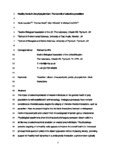Healthy herds in the phytoplankton: the benefit of selective parasitism
| dc.contributor.author | Laundon, D | |
| dc.contributor.author | Mock, T | |
| dc.contributor.author | Wheeler, G | |
| dc.contributor.author | Cunliffe, Michael | |
| dc.date.accessioned | 2022-02-08T15:41:26Z | |
| dc.date.issued | 2021-07 | |
| dc.identifier.issn | 1751-7362 | |
| dc.identifier.issn | 1751-7370 | |
| dc.identifier.uri | http://hdl.handle.net/10026.1/18715 | |
| dc.description.abstract |
The impact of selective predation of weaker individuals on the general health of prey populations is well-established in animal ecology. Analogous processes have not been considered at microbial scales despite the ubiquity of microbe-microbe interactions, such as parasitism. Here we present insights into the biotic interactions between a widespread marine thraustochytrid and a diatom from the ecologically important genus Chaetoceros. Physiological experiments show the thraustochytrid targets senescent diatom cells in a similar way to selective animal predation on weaker prey individuals. This physiology-selective targeting of 'unhealthy' cells appears to improve the overall health (i.e., increased photosynthetic quantum yield) of the diatom population without impacting density, providing support for 'healthy herd' dynamics in a protist-protist interaction, a phenomenon typically associated with animal predators and their prey. Thus, our study suggests caution against the assumption that protist-protist parasitism is always detrimental to the host population and highlights the complexity of microbial interactions. | |
| dc.format.extent | 2163-2166 | |
| dc.format.medium | Print-Electronic | |
| dc.language | en | |
| dc.language.iso | en | |
| dc.publisher | Springer Science and Business Media LLC | |
| dc.rights | Attribution-NonCommercial-NoDerivatives 4.0 International | |
| dc.rights | Attribution-NonCommercial-NoDerivatives 4.0 International | |
| dc.rights | Attribution-NonCommercial-NoDerivatives 4.0 International | |
| dc.rights.uri | http://creativecommons.org/licenses/by-nc-nd/4.0/ | |
| dc.rights.uri | http://creativecommons.org/licenses/by-nc-nd/4.0/ | |
| dc.rights.uri | http://creativecommons.org/licenses/by-nc-nd/4.0/ | |
| dc.subject | Animals | |
| dc.subject | Ecology | |
| dc.subject | Eukaryota | |
| dc.subject | Food Chain | |
| dc.subject | Humans | |
| dc.subject | Phytoplankton | |
| dc.subject | Population Dynamics | |
| dc.subject | Predatory Behavior | |
| dc.subject | Symbiosis | |
| dc.title | Healthy herds in the phytoplankton: the benefit of selective parasitism | |
| dc.type | journal-article | |
| dc.type | Journal Article | |
| dc.type | Research Support, Non-U.S. Gov't | |
| plymouth.author-url | https://www.webofscience.com/api/gateway?GWVersion=2&SrcApp=PARTNER_APP&SrcAuth=LinksAMR&KeyUT=WOS:000625521800001&DestLinkType=FullRecord&DestApp=ALL_WOS&UsrCustomerID=11bb513d99f797142bcfeffcc58ea008 | |
| plymouth.issue | 7 | |
| plymouth.volume | 15 | |
| plymouth.publication-status | Published | |
| plymouth.journal | The ISME Journal | |
| dc.identifier.doi | 10.1038/s41396-021-00936-8 | |
| plymouth.organisational-group | /Plymouth | |
| plymouth.organisational-group | /Plymouth/Faculty of Science and Engineering | |
| plymouth.organisational-group | /Plymouth/Faculty of Science and Engineering/School of Biological and Marine Sciences | |
| plymouth.organisational-group | /Plymouth/REF 2021 Researchers by UoA | |
| plymouth.organisational-group | /Plymouth/REF 2021 Researchers by UoA/UoA07 Earth Systems and Environmental Sciences | |
| plymouth.organisational-group | /Plymouth/Users by role | |
| plymouth.organisational-group | /Plymouth/Users by role/Academics | |
| dc.publisher.place | England | |
| dcterms.dateAccepted | 2021-02-10 | |
| dc.rights.embargodate | 2022-2-10 | |
| dc.identifier.eissn | 1751-7370 | |
| dc.rights.embargoperiod | Not known | |
| rioxxterms.versionofrecord | 10.1038/s41396-021-00936-8 | |
| rioxxterms.licenseref.uri | http://creativecommons.org/licenses/by-nc-nd/4.0/ | |
| rioxxterms.licenseref.startdate | 2021-07 | |
| rioxxterms.type | Journal Article/Review |



